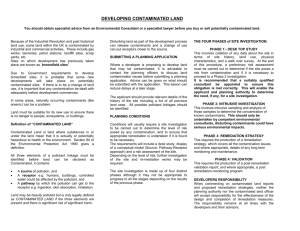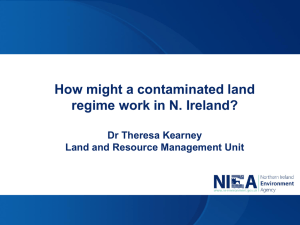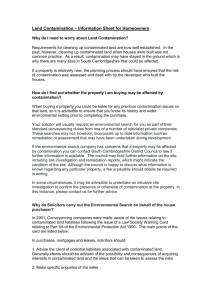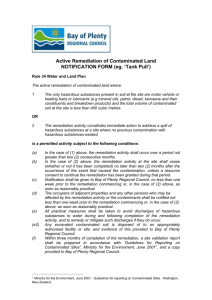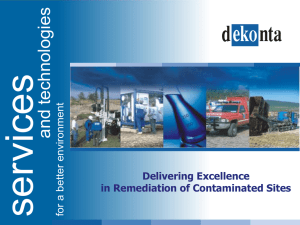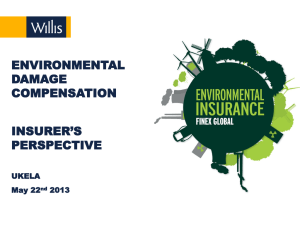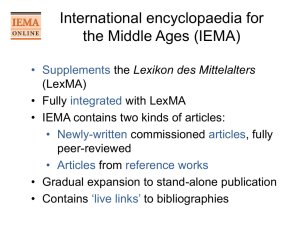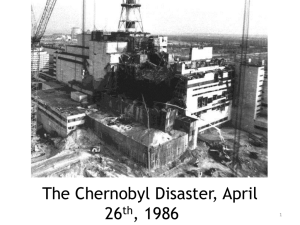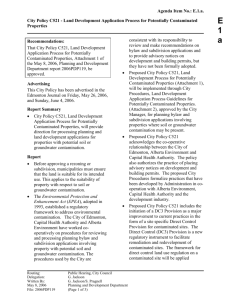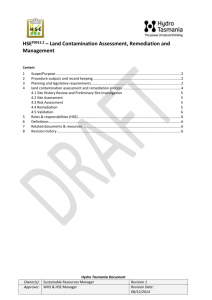RR07_johnson_tevol2
advertisement
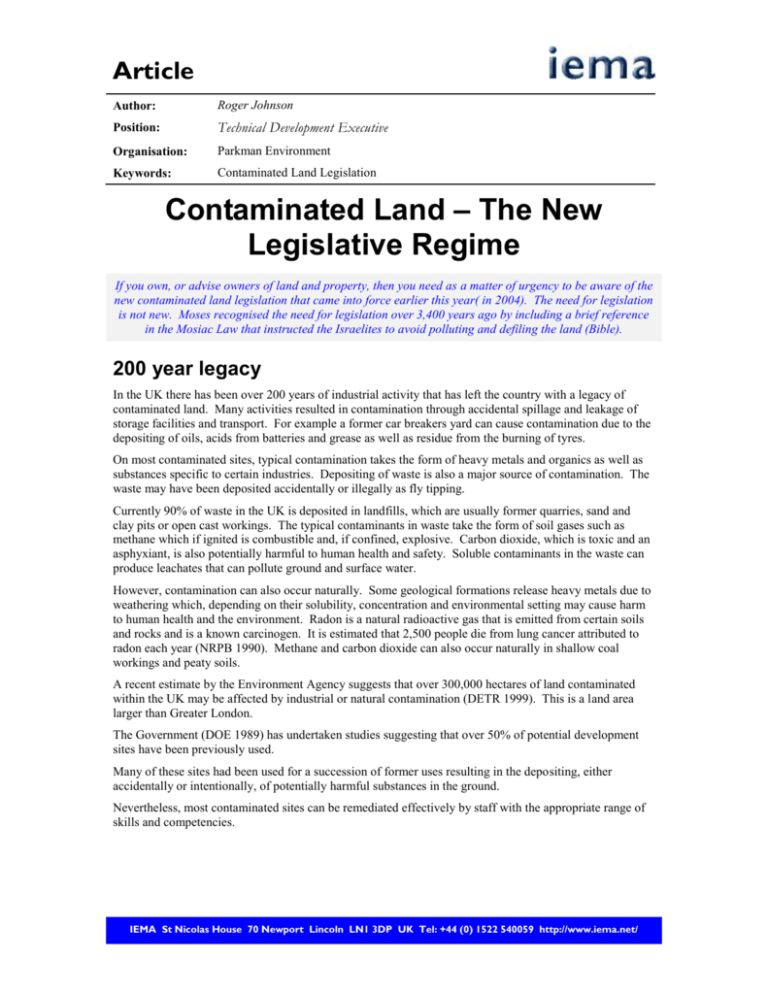
Article Author: Roger Johnson Position: Technical Development Executive Organisation: Parkman Environment Keywords: Contaminated Land Legislation Contaminated Land – The New Legislative Regime If you own, or advise owners of land and property, then you need as a matter of urgency to be aware of the new contaminated land legislation that came into force earlier this year( in 2004). The need for legislation is not new. Moses recognised the need for legislation over 3,400 years ago by including a brief reference in the Mosiac Law that instructed the Israelites to avoid polluting and defiling the land (Bible). 200 year legacy In the UK there has been over 200 years of industrial activity that has left the country with a legacy of contaminated land. Many activities resulted in contamination through accidental spillage and leakage of storage facilities and transport. For example a former car breakers yard can cause contamination due to the depositing of oils, acids from batteries and grease as well as residue from the burning of tyres. On most contaminated sites, typical contamination takes the form of heavy metals and organics as well as substances specific to certain industries. Depositing of waste is also a major source of contamination. The waste may have been deposited accidentally or illegally as fly tipping. Currently 90% of waste in the UK is deposited in landfills, which are usually former quarries, sand and clay pits or open cast workings. The typical contaminants in waste take the form of soil gases such as methane which if ignited is combustible and, if confined, explosive. Carbon dioxide, which is toxic and an asphyxiant, is also potentially harmful to human health and safety. Soluble contaminants in the waste can produce leachates that can pollute ground and surface water. However, contamination can also occur naturally. Some geological formations release heavy metals due to weathering which, depending on their solubility, concentration and environmental setting may cause harm to human health and the environment. Radon is a natural radioactive gas that is emitted from certain soils and rocks and is a known carcinogen. It is estimated that 2,500 people die from lung cancer attributed to radon each year (NRPB 1990). Methane and carbon dioxide can also occur naturally in shallow coal workings and peaty soils. A recent estimate by the Environment Agency suggests that over 300,000 hectares of land contaminated within the UK may be affected by industrial or natural contamination (DETR 1999). This is a land area larger than Greater London. The Government (DOE 1989) has undertaken studies suggesting that over 50% of potential development sites have been previously used. Many of these sites had been used for a succession of former uses resulting in the depositing, either accidentally or intentionally, of potentially harmful substances in the ground. Nevertheless, most contaminated sites can be remediated effectively by staff with the appropriate range of skills and competencies. IEMA St Nicolas House 70 Newport Lincoln LN1 3DP UK Tel: +44 (0) 1522 540059 http://www.iema.net/ Article Legislation Legislation has been introduced during recent years to tackle the contaminated land problem, but arguably the most significant came into force on the 1 April in England and the 14 July 2000 in Scotland. The Royal Institution of Chartered Surveyors has predicted that this legislation: will be the most important piece of legislation to affect the property industry for 50 years (Wilbourn 1997). The legislation brings into force Part IIA of the Environmental Protection Act 1990 that was inserted into the 1990 Act by section 57 of the Environment Act 1995. Drafts of the legislation were published for consultation in 1996, 1998 and 1999. Who will it affect? The legislation may affect all land and property owners as well as those who buy and sell land and property. Banks, building societies, insurance companies, developers, contractors as well as their professional advisers may all have potential liabilities and will need to include the provisions of the legislation within their working practices. New Definition Section 57 of the Environment Act 1995 defines contaminated land as: “Any land which appears to the Local Authority in whose area it is situated to be in such a condition, by reason of substances in, or under the land that: 1. Significant harm is being caused, or there is a significant possibility of such harm being caused; or 2. Pollution of controlled waters is being, or is likely to be, caused.” The legislation requires regulators to consider the effects of contamination on human health, certain protected ecological systems, property in the form of crops, livestock, property in the form of buildings and controlled waters. These are called as “receptors”. Regulators The primary regulators are the local authorities. They will be required to take a pro-active role in identifying contaminated land in their areas and securing remediation, preferably voluntarily but if necessary by serving of a remediation notice against the polluter and/or the land and property owner. They have the sole responsibility for determining whether the land is contaminated. However, the local authorities are required to undertake their duties in full consultation with the Environment Agency. The Agency will provide information on geological, hydrogeological, water quality and abstraction, past incidents of pollution and waste licensing. The Agency will become the enforcing authority in cases that are classified as 'special sites'. Sites with activities such as oil refining, waste acid tar lagoons, explosives, former Ministry of Defence sites, chemical and nuclear weapon establishments and where pollutants are affecting major aquifers would all be classified as 'special sites'. Local authorities are to develop written strategies for inspection that will be published within 15 months from the date of implementation i.e. before June 2001. The strategies must be kept under periodic review. Also, local authorities will collate documentary information, including old maps and records and aerial photographs in order to identify potential sources of contamination. If the documentary information suggests that the site may be contaminated the local authority will visit the site and in some cases take soil, gas and water samples. They have powers of access and can initiate an intrusive investigation involving digging trial pits and sinking of boreholes or probes. They will want to consult with the owner of the potentially contaminated site and with the polluter. IEMA St Nicolas House 70 Newport Lincoln LN1 3DP UK Tel: +44 (0) 1522 540059 http://www.iema.net/ Article Information will be key The acquisition and management of the information will be an onerous task. Albert Dunlop, Managing Director of land information company Land Aspects, sees this as a fundamental aspect for success of the legislation. “85% of all data is geographically fixed and an effective Geographic Information System will be essential for every Local Authority”. In making their determination, the local authority will seek to identify receptors that could be adversely affected by the presence of contaminants, for example, humans and controlled waters. For pollution of waters and significant harm to occur a link has to exist between the source of the pollution and the receptor. One or more significant links must be established for the site to be defined as contaminated. If significant pollutant linkages are found the local authority must identify who is liable. Those who are liable are called appropriate persons. Class A persons are those who cause or knowingly permit pollution, they are liable for the cost of remediating the land even if this involves off-site remediation caused by the migration of pollutants off-site. Inherited Liability If the local authority cannot find the Class A persons after what is termed, reasonable enquiry, the owner of the land may be liable for some of the remediation, even if they are not the polluter, and thereby becomes a Class B person. The scope of Class B persons' liability is limited to remediation within the curtilage of their land and they would not be required to undertake remediation to prevent water pollution. In some cases neither Class A nor Class B persons will be found, or they are found but may not have the resources to pay for the remediation. The site is then referred to as an orphan site and the taxpayer will fund the cost of the remediation. If the local authority identifies Class A or Class B persons, remediation notices are issued and the local authority enters into a three month consultation period. During this period the local authority will endeavour to persuade those who are liable to remediate voluntarily and will discuss phasing the remediation. If this is not achieved the local authority has the option to enforce remediation through the serving of a notice. Any person who receives a notice can appeal, either to a magistrate’s court if the notice was served by the local authority, or to the Secretary of State if the notice was served by the Environment Agency. If there is an imminent danger of serious harm or pollution of controlled waters, the enforcing authority may carry out the remediation and recover costs later. The authority can also carry out the remediation where the liable parties are unable to organise the remediation. The Government has committed £50 million in England and £10.7 million in Scotland over the next three years to assist local authorities develop their inspection strategies, carry out site investigations and take forward enforcement action. This funding is in addition to the £45 million already identified through the Contaminated Land Supplementary Credit Approval (SCA) programme, which provides support for capital costs incurred by local authorities in inspecting and remediating land. Land Owners To avoid being caught out, land and property owners should screen their property portfolios. Desk studies and site surveys should be carried out to identify land where there is the possibility of significant harm or pollution of controlled waters. This should be based upon past use and the environmental setting of the site. Rapid and effective screening techniques for these audits are available. After the initial screening, some land may require intrusive investigation and samples would be taken and tested. IEMA St Nicolas House 70 Newport Lincoln LN1 3DP UK Tel: +44 (0) 1522 540059 http://www.iema.net/ Article Vendors It may be tempting for those who own contaminated land or property to sell as quickly as possible, relying on the ‘buyer beware’ principle. However this will not necessarily break the liability chain, unless the site is remediated prior to sale. Alternatively the vendor is eliminated from liability if the buyer had information that identified the significant pollutant linkage prior to purchase. Purchasers Most purchasers organise a pre-acquisition survey prior to their purchase of land or property, but does the survey identify the environmental liabilities? In many instances land and property passes through the sale and transfer transaction without an environmental audit. Many new owners of land and property may not become aware of the liabilities until the enforcing authority contacts them. Therefore an audit prior to purchase is essential even if the vendor is offering the land as sold with information or as remediated prior to sale. The Future Proposals for further action have been made by the Urban Task Force, chaired by Lord Rogers of Riverside, in the report, Towards an Urban Renaissance (DETR 1999). In the report there is a proposal for the restoration of all polluted sites by the year 2030. The promised utopia of a clean and pleasant land, free of pollution after 200 years of industrial contamination will not dawn without pain. For those who do not understand the issues, either as land or property owners or as the professionals who act as advisors, architects, surveyors, engineers and solicitors, the risks of attracting liabilities are significant and the costs of remediation could be substantial. References Book of Numbers, Ch35, verses 33 and 34, Bible, New International Version. Board statement on radon in homes, Documents of the National Radiological Protection Board, Vol. 1, No. 1, HMSO, 1990. Draft Circular on Contaminated Land - September – Environmental Protection Act 1990, Part IIA, Annexe 1, Cl 5, DETR 1999. A Review of Derelict Land Policy, Department of the Environment, DOE 1989. Ground Engineering, Talking Point, Wilbourn, December 1997. Part 11A, Contaminated Land, Section 57, Section 78 to 78YC, Environment Act 1995, DETR 1999. Towards an Urban Renaissance: Report by the Urban Task Force, chaired by Lord Rogers of Riverside, DETR, June 1999. Notes This article is based on work undertaken by Parkman Environmental for the DETR and the Environment Agency on technical guidance documents and procedural reports to support implementation of the new legislation. This article was published in the IEMA's magazine in October 2000 IEMA St Nicolas House 70 Newport Lincoln LN1 3DP UK Tel: +44 (0) 1522 540059 http://www.iema.net/
